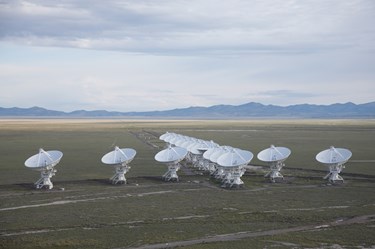Fast Radio Bursts Key To Explaining Dark Matter
By Jof Enriquez,
Follow me on Twitter @jofenriq

Fast radio bursts (FRBs) – brief yet intense flashes of radio waves known to originate from distant galaxies – could provide clues to the nature of dark matter, according to astrophysicists from Johns Hopkins University.
Dark matter is a mysterious substance that makes up about 27 percent of the material universe, and scientists know little about its full nature. Some of them speculate that some dark matter is made of primordial black holes formed at the beginning of the existence of the universe. A group of astrophysicists at Johns Hopkins published a research paper proposing that collision between these black holes, detected previously by the Laser Interferometer Gravitational-Wave Observatory (LIGO), prove that these objects indeed are made of dark matter.
LIGO's findings suggested that the merging black holes each had about 30 times the mass of our sun, which falls within the range of 29 to 36 solar masses predicted for dark matter.
Granting that fast radio bursts would have to cross vast distances of interstellar space – and presumably, black holes – an FRB would either be deflected when it passes a black hole or be split into two rays in the same direction, with one traveling a few milliseconds behind the other.
“The echoing of FRBs is a very direct probe of dark matter,” said Julian Muñoz, a Johns Hopkins graduate student, in a news release.
“While gravitational waves might ‘indicate’ that dark matter is made of black holes, there are other ways to produce very-massive black holes with regular astrophysics, so it would be hard to convince oneself that we are detecting dark matter. However, gravitational lensing of fast radio bursts has a very unique signature, with no other astrophysical phenomenon that could reproduce it,” said Munoz, who wrote with Ely D. Kovetz, Liang Dai, and Marc Kamionkowski in the study, which was published in Physical Review Letters.
Only about 20 fast radio bursts have been detected since 2001, but new instruments could allow scientists to catch more of these enigmatic cosmic flashes as they pass near massive compact halo objects (MACHOs), a class of dark matter candidates to which primordial black holes belong.
"Considering the expected FRB detection rate by upcoming experiments, such as Canadian hydrogen intensity mapping experiment (CHIME), of 104 FRBs per year, we should observe from tens to hundreds of repeated bursts yearly, if MACHOs in this window make up all the dark matter," the scientists wrote in the study.
Scientists also now know how to detect FRBs within seconds, and how to pinpoint the location of the FRB about 1000 times more precisely than for previous events, by following the flash's “radio afterglow” lasting six days before fading away.
